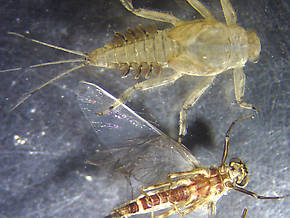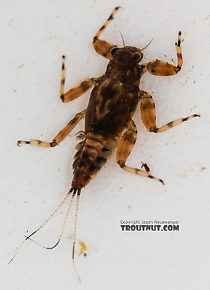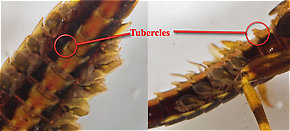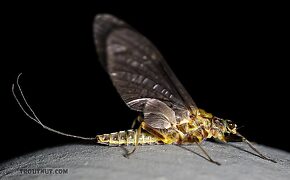Blog & Latest Updates
Fly Fishing Articles
Insects by Common Name


Mayfly Species Drunella flavilinea (Flav)
Taxonomic Navigation -?-
Kingdom
Animalia (Animals)
» Phylum
Arthropoda (Arthropods)
» Class
Insecta (Insects)
» Order
Ephemeroptera (Mayflies)
» Genus
Drunella (Blue-Winged Olives)
» Species flavilinea (Flav)
Common Names
Their hatches may be complemented by simultaneous hatches of two less prolific species, Drunella coloradensis and Drunella spinifera.
Where & When
They are reported in places from mid-June all the way through October, but they peak in most places sometime in July or August.
Hatching Behavior
Time Of Day (?): Flexible, but usually in the evening
Habitat: Quiet water adjacent to the fast-water nymphal habitat
Water Temperature: 55-57°F
According to Knopp & Cormier in Mayflies: An Angler's Study of Trout Water Ephemeroptera , Flavs emerge in the surface film rather than underwater like most other Drunella mayflies. Habitat: Quiet water adjacent to the fast-water nymphal habitat
Water Temperature: 55-57°F
The Flav duns don't have as much difficult getting off the water as their larger brethren, but they still linger longer as duns than most mayflies and provide good dry fly action.
Spinner Behavior
Time Of Day: Late morning, or evening
Habitat: Riffles
In Hatches II, Caucci and Nastasi say the spinner falls occur in the evenings. However, in Selective Trout, Swisher and Richards say that most of the spinners fall between 9am and 1pm and a few fall in the evening. Anglers with experience to clarify this contradiction are encouraged to write their observations in the comments.Habitat: Riffles
Nymph Biology
The nymphs occur in many habitats but they're most prolific in fast, rocky water.
Pictures of 3 Mayfly Specimens in the Species Drunella flavilinea:
Drunella flavilinea (Flav) Mayfly Spinner View 1 Pictures
View 1 Pictures
 View 1 Pictures
View 1 PicturesCollected July 31, 2010 from the Flathead River-lower in Montana
Added to Troutnut.com by Bnewell on June 29, 2011
Added to Troutnut.com by Bnewell on June 29, 2011
Drunella flavilinea (Flav) Mayfly Nymph View 6 PicturesAlthough the identification is not certain because the nymph is not yet mature, the configuration of tubercles (
View 6 PicturesAlthough the identification is not certain because the nymph is not yet mature, the configuration of tubercles ( Tubercle: Various peculiar little bumps or projections on an insect. Their character is important for the identification of many kinds of insects, such as the nymphs of Ephemerellidae mayflies.) on this one--particularly the forefemora--seems to best match Drunella flavilinea.
Tubercle: Various peculiar little bumps or projections on an insect. Their character is important for the identification of many kinds of insects, such as the nymphs of Ephemerellidae mayflies.) on this one--particularly the forefemora--seems to best match Drunella flavilinea.
 View 6 PicturesAlthough the identification is not certain because the nymph is not yet mature, the configuration of tubercles (
View 6 PicturesAlthough the identification is not certain because the nymph is not yet mature, the configuration of tubercles (
A few (not all) of the abdominal tubercles on this Ephemerella needhami nymph are circled. They are especially large in this species.
Collected July 2, 2019 from the Gallatin River in Montana
Added to Troutnut.com by Troutnut on July 18, 2019
Added to Troutnut.com by Troutnut on July 18, 2019
Female Drunella flavilinea (Flav) Mayfly Dun View 6 PicturesI can't be certain of the ID of this female dun, but I'm calling it Drunella flavilinea for three reasons: 1) the known abundance of "flavs" on the Henry's Fork, 2) clear differences in coloration from my confirmed specimens of Drunella coloradensis, which is the main lookalike, and 3) the habitat (a sizable river in a wide mountain valley, rather than a small, high-altitude stream) suggests it's not coloradensis.
View 6 PicturesI can't be certain of the ID of this female dun, but I'm calling it Drunella flavilinea for three reasons: 1) the known abundance of "flavs" on the Henry's Fork, 2) clear differences in coloration from my confirmed specimens of Drunella coloradensis, which is the main lookalike, and 3) the habitat (a sizable river in a wide mountain valley, rather than a small, high-altitude stream) suggests it's not coloradensis.
 View 6 PicturesI can't be certain of the ID of this female dun, but I'm calling it Drunella flavilinea for three reasons: 1) the known abundance of "flavs" on the Henry's Fork, 2) clear differences in coloration from my confirmed specimens of Drunella coloradensis, which is the main lookalike, and 3) the habitat (a sizable river in a wide mountain valley, rather than a small, high-altitude stream) suggests it's not coloradensis.
View 6 PicturesI can't be certain of the ID of this female dun, but I'm calling it Drunella flavilinea for three reasons: 1) the known abundance of "flavs" on the Henry's Fork, 2) clear differences in coloration from my confirmed specimens of Drunella coloradensis, which is the main lookalike, and 3) the habitat (a sizable river in a wide mountain valley, rather than a small, high-altitude stream) suggests it's not coloradensis.Collected July 31, 2020 from the Henry's Fork of the Snake River in Idaho
Added to Troutnut.com by Troutnut on August 16, 2020
Added to Troutnut.com by Troutnut on August 16, 2020
Your Thoughts On Drunella flavilinea:
Top 10 Fly Hatches
Top Gift Shop Designs
Eat mayflies.
Top Insect Specimens
Miscellaneous Sites
Troutnut.com is copyright © 2004-2024 Jason
Neuswanger (email Jason). See my FAQ for information about use of my images.
 privacy policy
privacy policy
